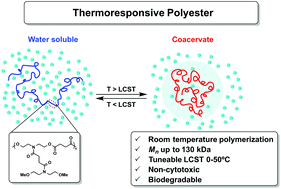A coacervate-forming biodegradable polyester with elevated LCST based on bis-(2-methoxyethyl)amine†
Abstract
Recently, we reported a new class of biodegradable, thermoresponsive polyesters (TR-PEs) inspired by polyacrylamides and elastin-like peptides (ELPs). The polyesters exhibit tunable cloud point temperatures (Tcp) and thermoresponsive coacervation in aqueous solution as shown via UV-vis spectroscopy, 1H NMR, and DLS. However, the Tcp of all TR-PEs remained low (<15 °C), and higher thermoresponsivity would be beneficial for many applications. This study examines the synthesis, polymerization, and analysis of a new monomer bearing a more hydrophilic pendant group, bis-2-methoxyethylamine (bMoEtA). The resulting TR-PE, TR-bMoEtAPE, displays a threefold increase in Tcp (ca. 50 °C) that is affected by solution (DI water vs. phosphate buffered saline), concentration (1–40 mg mL−1) molecular weight (20–130 kDa), and cosolutes (Hofmeister salts and urea). The Tcp and Tg of random TR-bMoEtAPE copolymers can be tuned via comonomer feed. Variable temperature 1H NMR indicated a cooperative coacervation mechanism above Tcp, further reinforced by DLS measurements. As evidenced by UV-vis and SEC analysis, TR-bMoEtAPE underwent rapid degradation over a period of 7 days in DI water and PBS. Finally, cytotoxicity studies suggested that TR-bMoEtAPE is non-cytotoxic even at high concentrations (ca. 1000 μg mL−1). The increased Tcp and tunability suggests TR-bMoEtAPE as a potential candidate for future functionalized TR-PE therapeutic-delivery systems.


 Please wait while we load your content...
Please wait while we load your content...